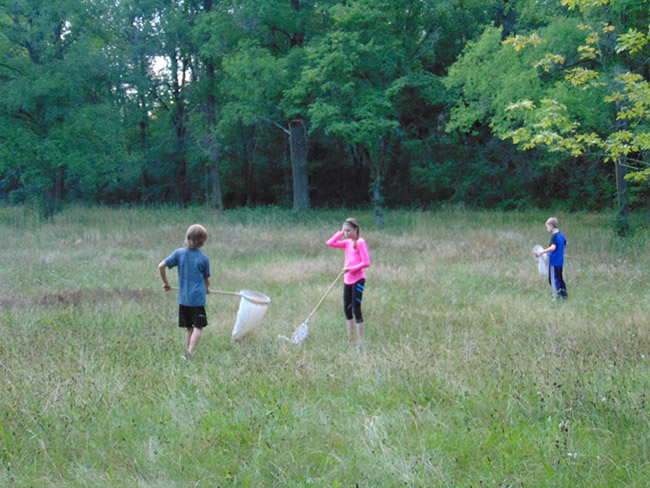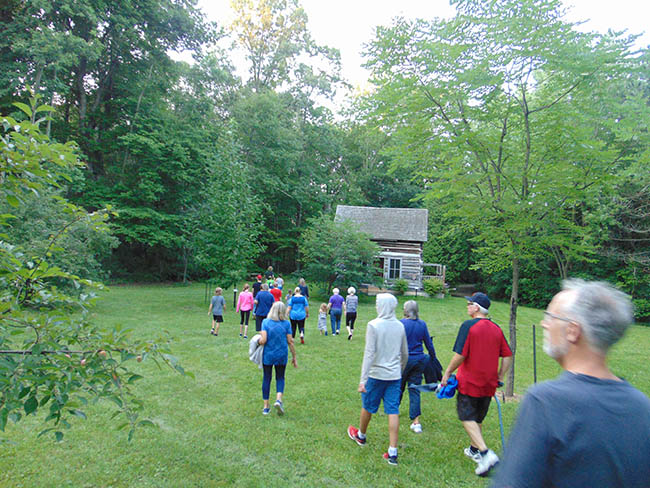Healthy Hikes – Why Outdoor Experiences Make Us Feel So Good

Healthy kids + healthy fun = healthy adults.
Take a Step Toward Good Health
2,400 years ago, Hippocrates said, “Walking is a man’s best medicine.” The following quote and the calorie burning information are from Harvard Medical School’s Harvard Health Publications webpage:
“like other forms of regular moderate exercise, walking improves cardiac risk factors such as cholesterol, blood pressure, diabetes, obesity, vascular stiffness and inflammation, and mental stress. And if cardiac protection and a lower death rate are not enough to get you moving, consider that walking and other moderate exercise programs also help protect against dementia, peripheral artery disease, obesity, diabetes, depression, colon cancer, and even erectile dysfunction.”
Your walk along a forested trail at Longwoods Road Conservation Area is helping you burn:
| Your weight | Approximate calories per 1.6km (1 mile) |
| 54.43kg (120 lbs) | 85 |
| 63.5kg (140 lbs) | 95 |
| 72.6kg (160 lbs) | 105 |
| 81.65kg (180 lbs) | 115 |
| 90.7kg (200 lbs) | 125 |
| 99.8kg (220 lbs) | 135 |
So enjoy your walk and your health. You’ve got a lot to appreciate!

Did you know forest and wetland ecosystems make us healthy?
What’s in a green space that makes us feel so good?
Walking outside has been proven to provide physical and mental health benefits such as:
- Increased weight loss and fitness
- Increased immunity
- Reduced risk of diabetes, heart disease and high blood pressure
- Improved balance and coordination
- Increased bone density reducing risk of osteoporosis
- Green spaces reduce human exposure to air pollutants, thereby reducing risk factors for cardiovascular and respiratory diseases
- A walk in nature treats mild depression as effectively as taking an antidepressant drug. Regular use of natural areas for physical activity can reduce the risk of mental health problems by 50%
- Contact with nature (including trees, lakes, rivers, plants, blue skies) can provide stress relief, reduce brain fatigue, enhance the five senses, and improve memory, mood, positive thinking, decision-making ability, mental sharpness, creativity, and attention span
Behind the Scenes
Spring and summer rains fall from sky to ground. Percolating through the porous soil the moisture is taken up by the myriad of forest mycorrhizae. These tiny fungal “root” networks thread throughout the soil beneath our feet, and are responsible for up to 80% of a forest tree’s water uptake. The fungi absorb nutrients contained in the tree roots, forming what is known as a symbiotic relationship, meaning both parties benefit from each other.
The water travels upward through the forest plant to where the leaves do their daytime magic in the form of photosynthesis – the reason we are all here breathing oxygen, the (lucky for us) byproduct of the plant’s sugar production. Photosynthesis occurs during the day when sunlight is available and produces more oxygen than is used by the plant’s nighttime respiration.
During the night, while the gray treefrogs, spring peepers, and owls are calling, the trees and forest plants respire. Respiration is the process where oxygen is used to process nutrients to fuel cells and is necessary for all living organisms. Carbon dioxide or CO2 is a byproduct of respiration, but once again – lucky for us – photosynthesis uses CO2 faster than respiration produces it. Our constant burning of fossil fuels produce a huge amount of CO2 and the forest ecosystem removes much of that plus many forms of air pollutants from the atmosphere, allowing us to live healthier lives.
Ecosystem Health
Obviously, without a healthy ecosystem our personal health suffers as well. Waters, forests, fields, skies and all their inhabitants are facing huge challenges to their existence. The impacts of Climate Change alone will cause an increase in:
- Vector-borne diseases (West Nile virus and Lyme disease)
- Extreme weather impacts (Injury and illness due to flooding)
- Temperature related illness (heat stress, hypothermia)
- Air-quality effects (Cardiopulmonary diseases, asthma)
- Water and food contamination
But it’s not only Climate Change that’s affecting our environment. Other challenges include habitat depletion, loss of biodiversity, human population encroachment and corporate exploitation of wild spaces, pollution, alien invasive species and more.
Let’s all keep our environment and ourselves healthy. See you on the trails!
Resources
EcoHealth. (2017). [Text and graphics listing benefits of nature to human physical and mental health]. EcoHealth Handout_1_1.pdf. Retrieved from http://www.ecohealth-ontario.ca/files/EcoHealth_Handout_1_1.pdf
What’s New?
- Watershed Condition Statement – Safety Bulletin – Thames River – April 7, 2025 – 12:00 PM
- Flood Watch – Thames River and smaller watercourses – April 6, 2025 – 1:00 PM
- Flood Watch – Thames River and smaller watercourses – April 5, 2025 – 9:00 AM
- Flood Watch – Thames River and smaller watercourses – April 3, 2025 – 3:00 PM
- Watershed Condition Statement – Flood Outlook – Smaller watercourses and Thames River – April 1, 2025 – 2:00 PM
